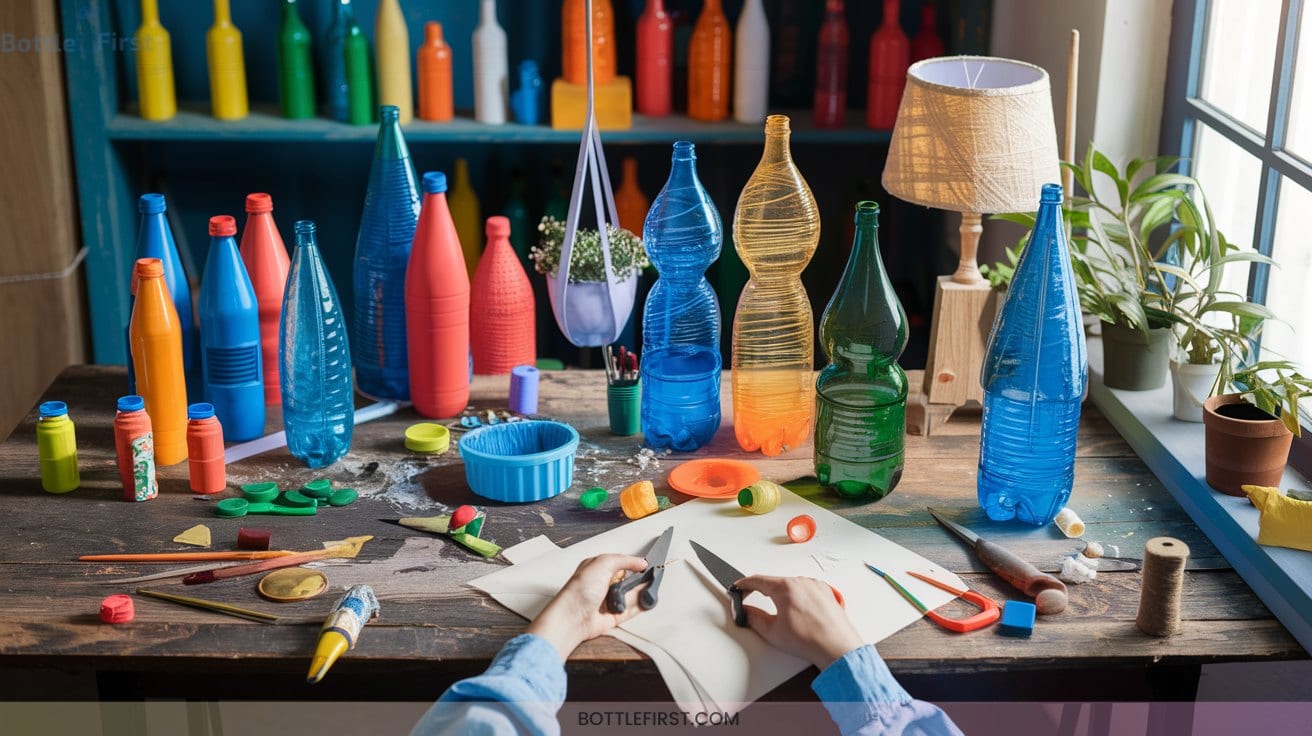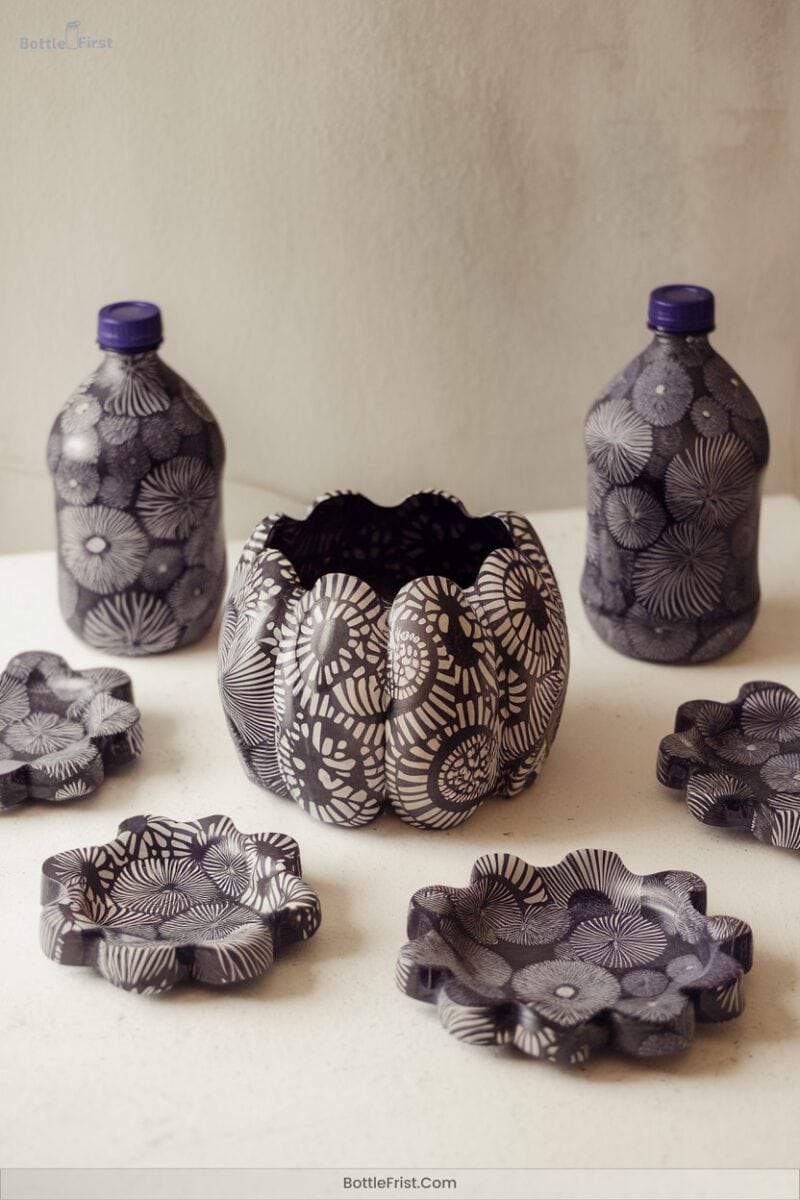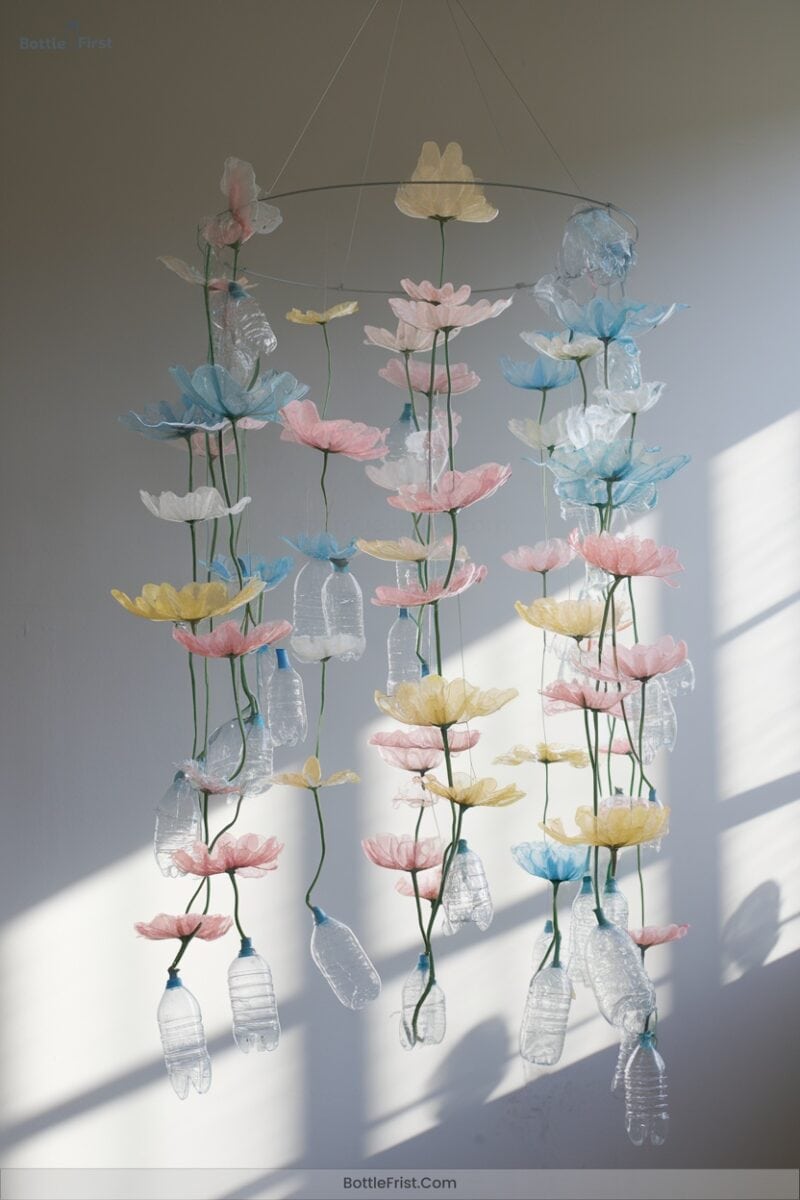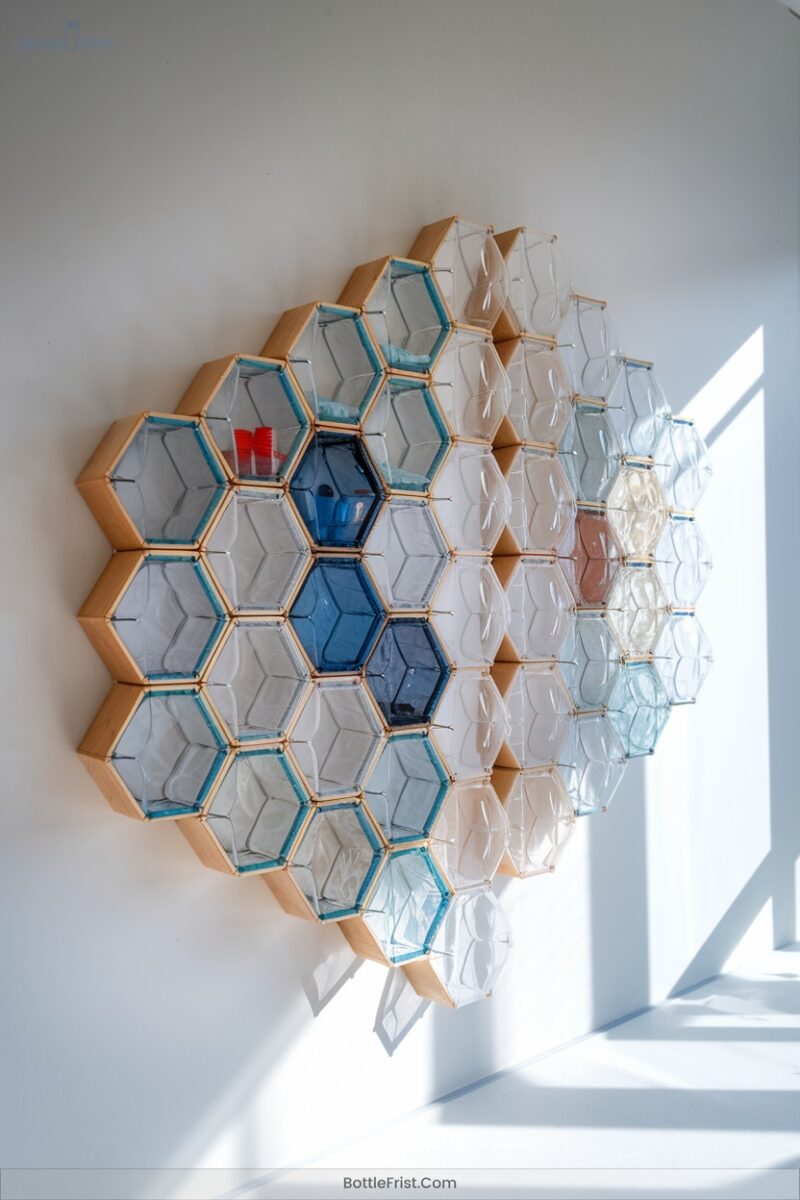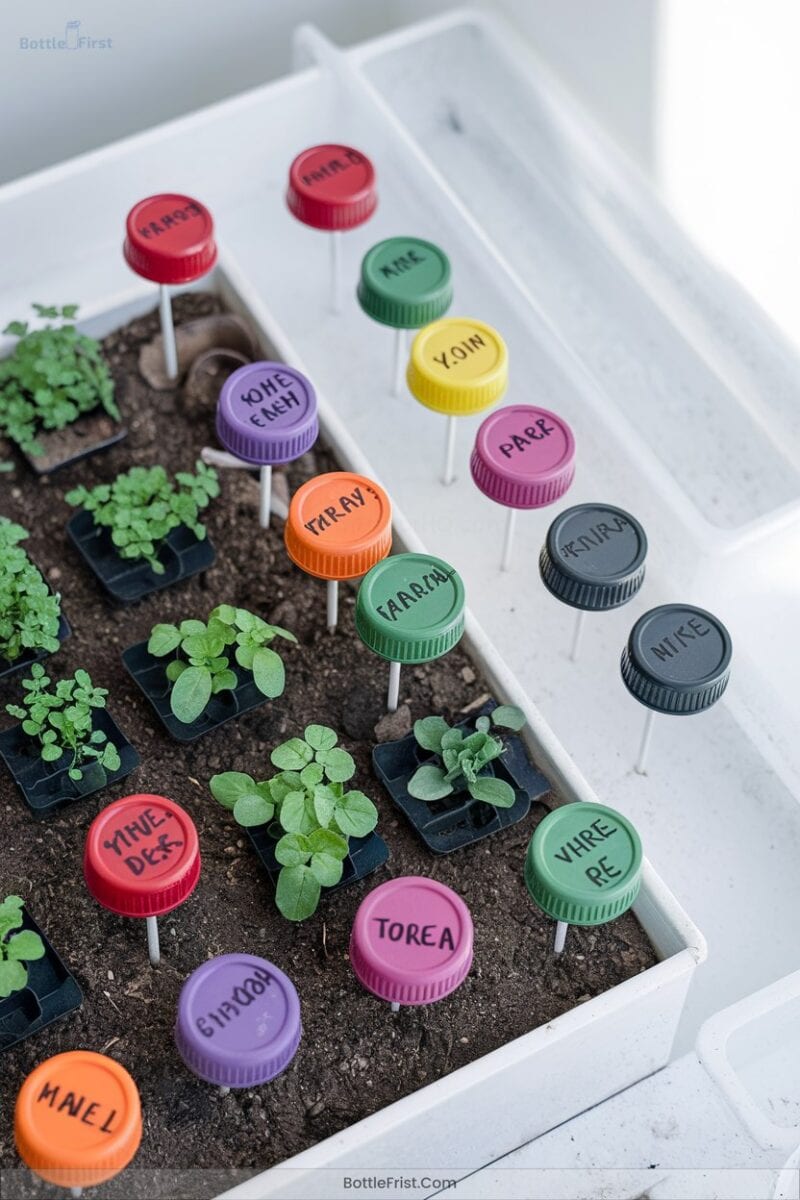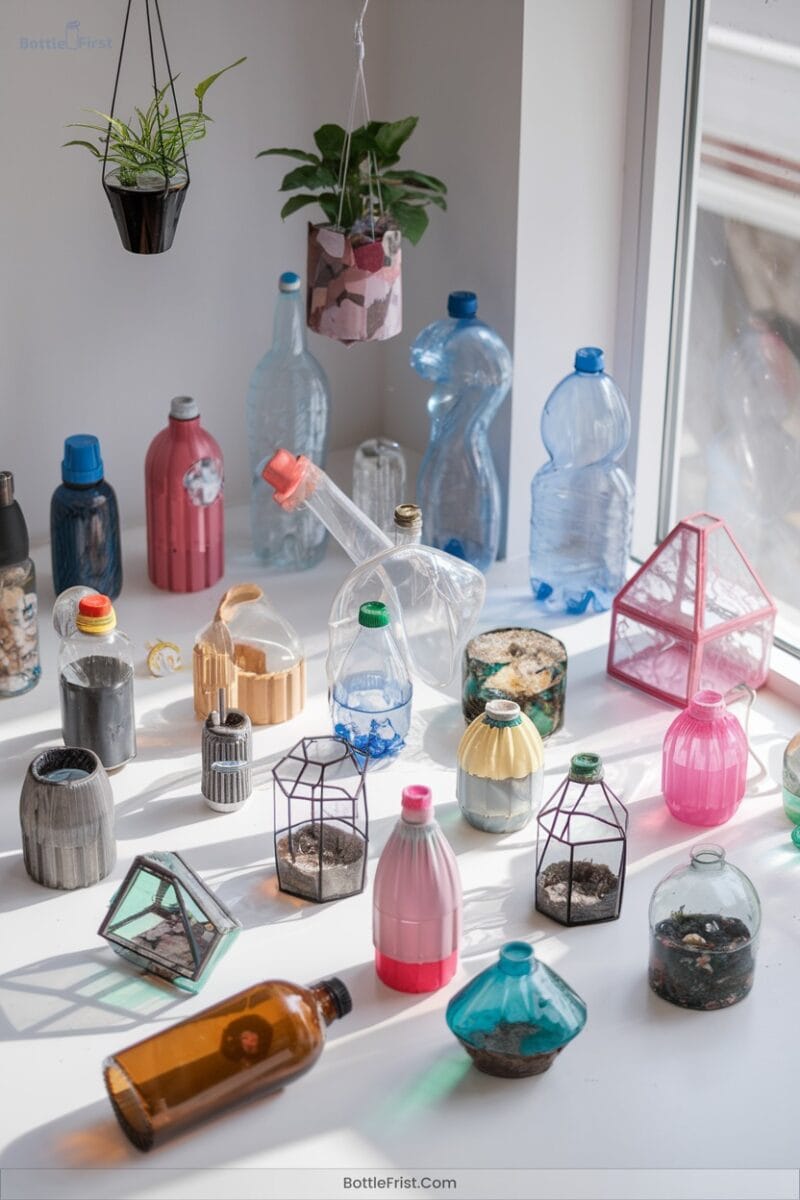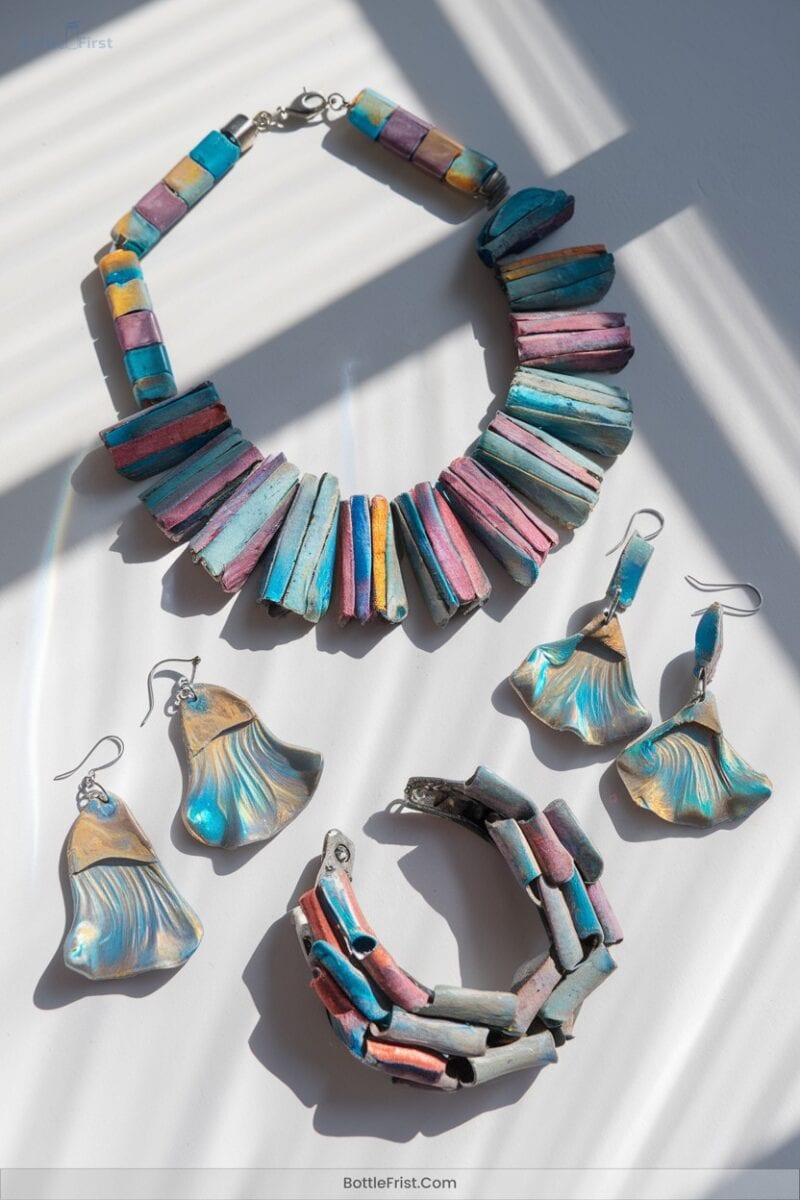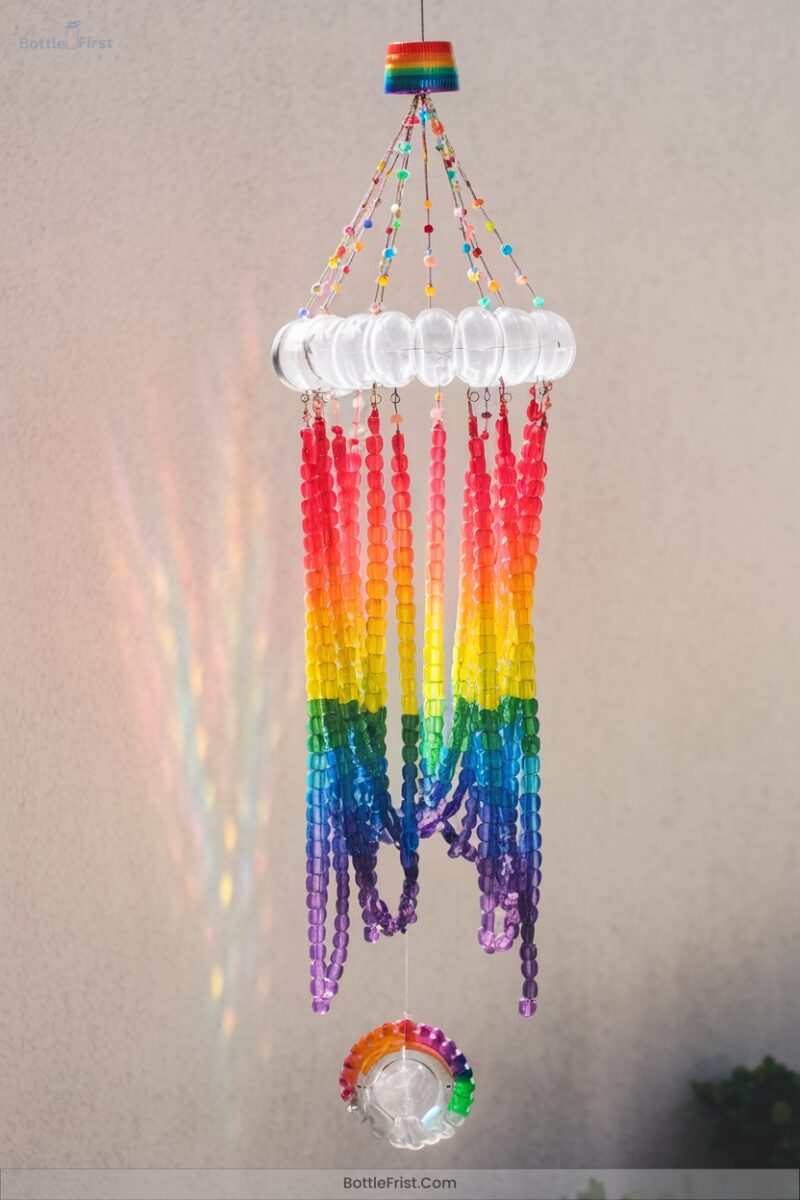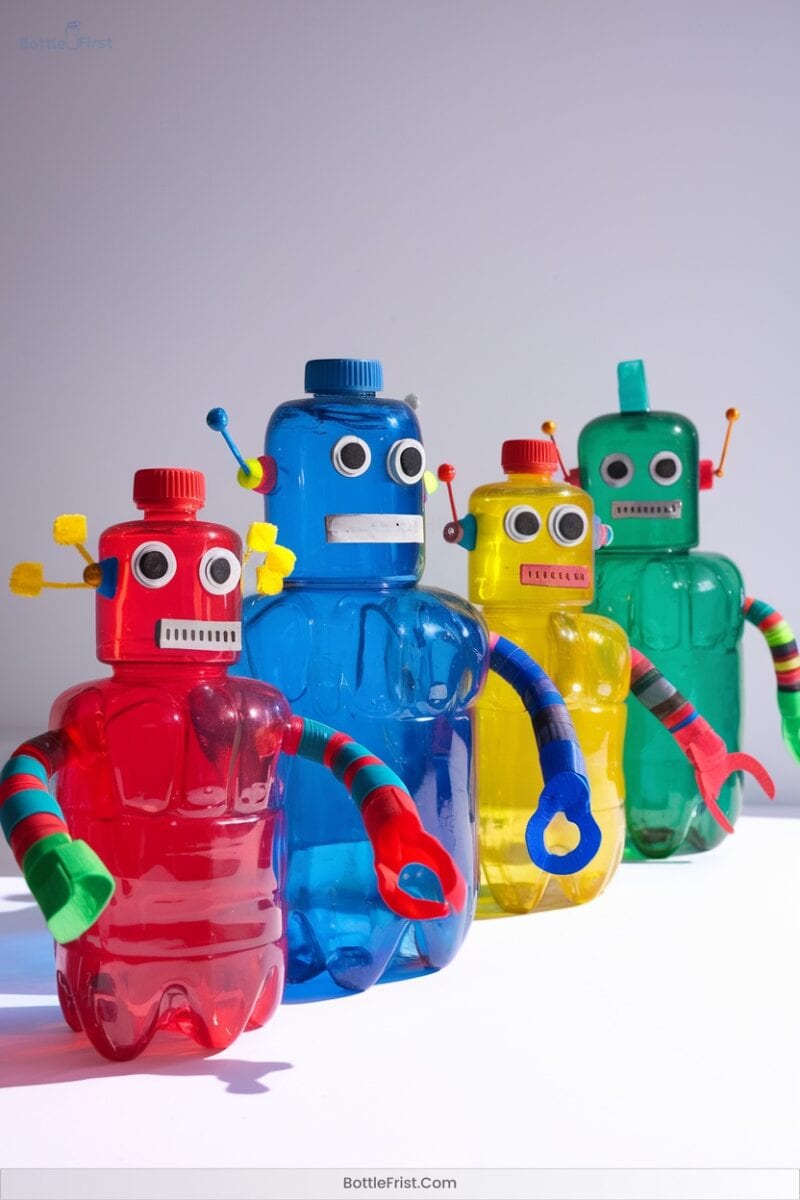20 Mind-Blowing Creative Plastic Bottle Art Projects
Transforming used plastic bottles into art is a trend not to be missed. You can craft stunning decoupage tabletops and vivid geometric wall frames. Create luminous centerpieces with LED and glitter glue, or design cascading floral mobiles with curled petals.
Innovative projects like turtle yarn vases or rainbow bead wind chimes bring whimsy into your space. From textured collage canvases to stylish bottle jewelry, there’s a myriad of ideas ready to redefine plastic waste and spur your creative journey.
1. Decoupage Tabletop Decorations
Transforming ordinary plastic bottles into decoupage tabletop decorations is a creative way to add an artistic flair to your home while promoting sustainability.
Begin by meticulously preparing surfaces; degrease with alcohol-based solutions and sand for ideal adhesion. Apply gypsum primer for texture, followed by vibrant acrylic or chalk paint.
Choose three-ply napkins or rice paper for intricate designs. Carefully tear edges for seamless blending and apply thin Mod Podge layers to avoid damage.
Finish with multiple varnish coats to guarantee durability and water resistance.
Elevate your creations with stands, turning them into striking centerpieces that beautifully merge functionality and artistry.
2. Geometric Wall Art Frames
Geometric wall art frames are a chic and contemporary way to reinvent your space with a touch of modern elegance. Using recycled plastic bottles, you can craft unique designs that captivate the eye and spark conversation.
This trend embraces sustainability while adding avant-garde flair to your home decor. Cut the bottles into precise shapes, then assemble them into intricate patterns. The interplay of shadows and light against your wall creates a dynamic visual experience.
It’s not just art—it’s a statement of innovation and eco-consciousness. So, transform your walls with these stunning frames and join the creative revolution.
3. Luminous Bottle Centerpieces
From enchanting wall art frames to fascinating table centerpieces, your home can become a canvas for creativity and sustainability.
Immerse yourself in the world of luminous bottle centerpieces by starting with transparent bottles to maximize the glow effect. Clean them thoroughly for a seamless finish.
Install battery-operated LED lights or cork lights inside for a mesmerizing illumination. Add fluid flow effects using a mix of Elmer’s glitter glue and hot water. Enhance visibility with glow-in-the-dark paint and stars.
Spray a uniform white base, then decorate with artificial foliage or embossed snowflakes. Each piece transforms your space into a beacon of innovation.
4. Cascading Floral Mobiles
In the world of eco-conscious design, few projects captivate like cascading floral mobiles, a perfect synthesis of art and sustainability.
Transform recycled plastic soda bottles into stunning, multi-dimensional blooms. Use sharp scissors and a utility knife to craft graduated petals from bottle sections, then curl them gently with candle heat for naturalistic shapes.
Paint petals in vibrant rainbow hues and secure them to sturdy 16-gauge stem wire. Assemble your mobile by threading large plastic beads onto thick yarn, adjusting flower spacing with precise knotting.
Anchor the structure with a painted branch or embroidery hoop for a visually striking cascade.
5. Turtle Yarn Vases
Immerse yourself in the enchanting world of turtle yarn vases, where artistic flair meets eco-friendly innovation.
Start by repurposing plastic bottles to form charming turtle shapes. Wrap them in colorful yarn, or choose eco-conscious alternatives like t-shirt strips or plastic bags for a unique texture. Use a hot glue gun or Elmer’s glue to attach the legs, head, and tail, creating a whimsical creature.
Scissors will help you refine shapes and weave yarn seamlessly. Finish your masterpiece with markers or paint to add expressive facial features.
This trend not only celebrates creativity but also champions sustainable artistry.
6. Self-Watering Planters
While exploring sustainable gardening solutions, self-watering planters made from plastic bottles stand out as both practical and innovative.
Imagine turning a simple 2-liter bottle into a mini ecosystem! Start by cutting the bottle at its shoulder, then invert the top into the base to form a reservoir.
Thread a cotton or synthetic wick through a perforated cap, guaranteeing it dangles in the water below. Fill the upper section with potting soil and seeds.
This design guarantees plants get consistent moisture, reducing maintenance. Embrace this eco-friendly trend and transform everyday waste into functional art, fostering a greener, more innovative lifestyle.
7. DIY Bird Feeders
Exploring sustainable gardening solutions naturally leads to another innovative use for plastic bottles: creating DIY bird feeders.
With a blend of creativity and eco-consciousness, transform ordinary 2-liter bottles into avian havens. Durable and transparent, these bottles invite you to cut strategic drainage and feeding holes, ensuring seeds stay dry and accessible.
Transform ordinary 2-liter bottles into bird feeders, ensuring seeds remain dry and accessible through strategic cuts.
Insert sticks or skewers for perches, and hang your creation with twine, allowing birds to feast comfortably. Experiment with cross-shaped perches or decorative roofs for style and function.
These feeders not only reduce plastic waste but also foster a vibrant ecosystem, inviting feathered friends to your innovative garden.
8. Modular Storage Solutions
When it comes to optimizing home organization, modular storage solutions crafted from plastic bottles offer both versatility and sustainability.
By using 2-gallon plastic jugs with cleverly designed grooves, you can create a seamless interlocking system without extra hardware. White string tied in figure-8 knots adds tension, ensuring stability, while optional hot glue reinforces connections.
Explore vertical or horizontal configurations to fit your unique space. Innovative wall-mounted holders and undercabinet racks transform unused areas, while magnetic holders attach bottles to refrigerator sides for easy access.
These stackable systems maximize shelf and counter space, embodying the perfect blend of creativity and efficiency.
9. Vertical Herb Gardens
As you venture into the domain of vertical herb gardens, you’ll discover a sustainable and innovative way to cultivate fresh herbs at home.
Modify plastic bottles by cutting side openings for planting and drilling holes for drainage. Secure them on wood trellises or metal trolleys for efficient vertical setups.
Prioritize HDPE2 bottles for safety, adding UV protection like waterproof paints. Integrate smart water management with drip systems and rainwater reservoirs.
Opt for HDPE2 bottles, enhance with UV protection, and employ efficient water systems for sustainable gardening.
Choose herbs wisely—basil, thyme, mint thrive here—and enrich soil with microbial-rich compost.
Monitor moisture levels closely, ensuring ideal growing conditions. This trend marries eco-consciousness with functional design.
10. Peg Lid Plant Markers
Transforming plastic jar lids into peg lid plant markers is a creative and efficient way to organize your garden.
It’s innovative, sustainable, and brings a touch of personalization to your outdoor space. Embrace this trend with these steps:
- Material Selection: Choose lids and stakes that suit your style, whether vibrant or minimalist.
- Design Customization: Use color-coded bases, patterns, and symbols to make your markers unique.
- Assembly Process: Secure lids to stakes with strong adhesive and make certain they penetrate the soil.
- Weather Protection: Apply a crafting seal to maintain vibrancy and durability.
Let your garden reflect your creativity!
11. Upcycled Material Workflow
Embracing an upcycled material workflow isn’t just a trend; it’s a leap towards sustainable creativity.
You start by meticulously cleaning and sorting plastic bottles, transforming them into a palette of potential. Pre-processing involves strategic planning, from removing labels to cutting bottles into modular parts.
Heat manipulation and precision cutting reveal new dimensions, while adhesive bonding and reinforcement layering build structural integrity. Integrate designs with modular mockups and verify symmetry for seamless artistry.
Heat manipulation unveils new dimensions, while adhesive bonding and layering fortify the structure for seamless, symmetrical artistry.
Surface treatments like priming and weatherproofing guarantee durability and aesthetic appeal.
This innovative process not only reduces waste but also reshapes your creative horizons.
12. Bio-Based Plastic Substitutes
While upcycled material workflows offer an innovative approach to reimagining plastic waste, exploring bio-based plastic substitutes can further enhance your sustainable creativity.
These alternatives transform everyday items into eco-friendly marvels. Imagine the possibilities:
- Mushroom-based packaging: Home-compostable and perfect for protecting fragile objects, these materials mimic Styrofoam.
- Seaweed polymers: Lightweight, marine-friendly, and they decompose within weeks.
- Avocado seed biopolymers: Transform pits into biodegradable cutlery and containers that enrich landfills.
- Shrimp shell-derived shrilk: Flexible, chitin-based items break down quickly, enriching the soil.
13. Closed-Loop Community Programs
As communities increasingly recognize the importance of sustainable practices, closed-loop community programs are emerging as an essential trend in reducing plastic waste.
They’re revolutionizing recycling by replacing 50,000 single-use bottles annually with aluminum alternatives, cutting plastic waste by 1.8 tons. Engaging over 30 local businesses, these programs prioritize equitable recycling access for millions of U.S. households.
With $400M+ in industry funds, they modernize infrastructure, boosting material recovery and creating local jobs. Educational campaigns further lower contamination rates by 15-20%.
14. Chemical Recycling Experiments
Building on the momentum of closed-loop community programs, the exploration of chemical recycling experiments offers a promising frontier in plastic waste management.
Imagine transforming waste into resources through groundbreaking methods that redefine recycling.
- Solvent-based separation promises high recovery rates, though scalability needs refining.
- Enzymatic degradation using engineered enzymes rapidly breaks down PET, releasing upcycling potential.
- Electrolytic decomposition visually reveals plastic breakdown, with ambitions to tackle mixed waste.
- Catalytic depolymerization efficiently targets polyester, converting it to value-added products.
You’re at the cutting edge, where each innovation carries the hope of a more sustainable future.
15. Wearable Art Accessories
Through the imaginative lens of wearable art accessories, PET plastic bottles are transformed into enchanting and sustainable fashion statements. By shredding, melting, and reforming these bottles, you can create stunning accessories like vibrant beads and lightweight cords.
Ocean waste, too, metamorphoses into durable materials, offering a guilt-free way to accessorize. Colored with eco-friendly dyes, these pieces not only captivate with their vivid aesthetics but also promote sustainability.
Embracing this trend reduces reliance on virgin plastics and aligns with circular economy principles. Immerse yourself in this innovative fashion movement, where style meets environmental consciousness, and redefine your wardrobe with a touch of creativity.
16. Easy Washable Bottle Lamps
Picture a scene where creativity meets functionality with easy washable bottle lamps. These innovative pieces bring an artistic glow to any space while being eco-friendly.
Start by selecting cylindrical plastic bottles and combine them with energy-efficient LEDs or solar bulbs. Here’s how to inspire:
- Structural Artistry: Transform bottles into spherical or shield shapes using rubber bands.
- Seamless Design: Secure components with joint compound for a sleek look.
- Technological Integration: Fit sockets in caps, threading clear cords effortlessly.
- Safety First: Ascertain electrical compliance and weatherproofing using UL-standard components.
Your space will shine with sustainable, creative brilliance.
17. Rainbow Bead Wind Chimes
Crafting rainbow bead wind chimes from plastic bottles is an inspiring way to combine artistic expression with sustainability.
Start by shaping clear bottles into tapered tops or spirals, perfect for sound variation. Paint these with vibrant acrylics, sealing them with outdoor varnish for durability.
Use synthetic yarn to thread assorted beads, buttons, and straws, creating dynamic visual and textural contrasts. Secure these strands through punched holes, adding clay or aluminum elements for kinetic charm.
With mixed material layers, you’ll achieve rich, resonant tones. Customize designs with thematic colors or glitter accents, crafting a unique, eco-friendly wind chime masterpiece.
18. Color-Coded Bottle Robots
Exploring creative uses for plastic bottles doesn’t stop with wind chimes; color-coded bottle robots offer an innovative way to blend art with technology.
Color-coded bottle robots ingeniously merge art with technology, transforming plastic waste into interactive engineering wonders.
These robots come alive with:
- Vibrant bottle bodies: Clear and colored variants create stunning visual contrasts.
- Dynamic movement: Electric toothbrushes provide motors, while colored bases simplify assembly.
- Intelligent design: Color-coded caps distinguish functional parts, enhancing educational engagement.
- Interactive learning: Apps control RGB LED-equipped bots, promoting personalized designs.
You’ll find that color-coded bottle robots aren’t just art—they’re a gateway to exploring engineering, creativity, and technology, sparking curiosity in any setting.
19. Texture Collage Canvases
When you explore the world of texture collage canvases, you’re not just creating art; you’re engaging in a tactile investigation that merges traditional and unconventional materials.
Embrace the fluidity of paint mixes, applying them with empty paint bottles onto tissue paper to craft organic patterns. A quick water spray enhances the flow, producing dynamic, textured layers.
Utilize plastic surfaces for easy layer removal and bottle contours to craft compelling facial outlines. Transform plastic bags into textured tree trunks, while bottle caps become vibrant leaves or striking sun motifs.
Corrugated cardboard adds depth, making your canvas truly multidimensional and innovative.
20. Repurposed Bottle Jewelry
Transforming discarded plastic bottles into stunning jewelry pieces isn’t only a creative endeavor but also a statement of sustainable fashion. By harnessing PET/HDPE materials, you craft vibrant designs that embrace innovation.
Visualize these steps:
- Material Magic: Cut and pre-treat plastic, revealing textures with markers.
- Design Alchemy: Shape rectangles into elegant teardrops, adding color-blocked flair.
- Structural Symphony: Punch holes and wire-wrap components, creating layered, dynamic pieces.
- Eco-Chic Impact: Craft outdoors, recycle all non-plastic remnants, and showcase alongside bottle origins.
Evoke elegance by fusing art and ecology, making waste wearable.
Frequently Asked Questions
How Do You Safely Cut Plastic Bottles Without Special Tools?
You can safely cut plastic bottles using household tools by carefully scoring with a sharp knife, then using scissors for smoother edges. Wear gloves for protection, guarantee a stable work surface, and mark cuts precisely with a dry-erase marker.
Can Plastic Bottle Projects Withstand Outdoor Weather Conditions?
Imagine a ship weathering a storm; your plastic bottle projects can do the same. By integrating UV protection, twine wrapping, and structural reinforcements, they endure outdoor elements, reflecting innovation’s resilience in sustainable art trends.
What Types of Glue Work Best on Plastic Surfaces?
You’ll find cyanoacrylate ideal for precision on hard plastics, while two-part epoxy offers durability for polypropylene. Plastic cement bonds PVC effectively. For quick fixes, hot melt glue works wonders, setting rapidly with heat application.
Are There Any Non-Toxic Sealants for Bottle Art?
Did you know that plant-based sealants make up 30% of the eco-friendly market? They’re perfect for your bottle art, offering zero-VOC, flexible finishes. Trendsetters like you will appreciate their safety and vibrant color compatibility.
How to Remove Labels and Residue From Plastic Bottles?
To remove labels from plastic bottles, immerse them in hot water, then peel. For sticky residue, apply a baking soda and oil paste. Explore sustainable alternatives like peanut butter for an innovative, non-toxic cleaning approach.
Conclusion
You’ve explored a vibrant array of plastic bottle art projects, each more imaginative than the last. Did you know that over 1 million plastic bottles are purchased every minute worldwide? Imagine transforming even a fraction of these into cascading floral mobiles or luminous centerpieces.
It’s a trend gaining momentum, as more creators embrace sustainability in their crafts. By reimagining waste, you’re not just crafting art—you’re contributing to a colorful, eco-conscious movement that’s reshaping our future.
